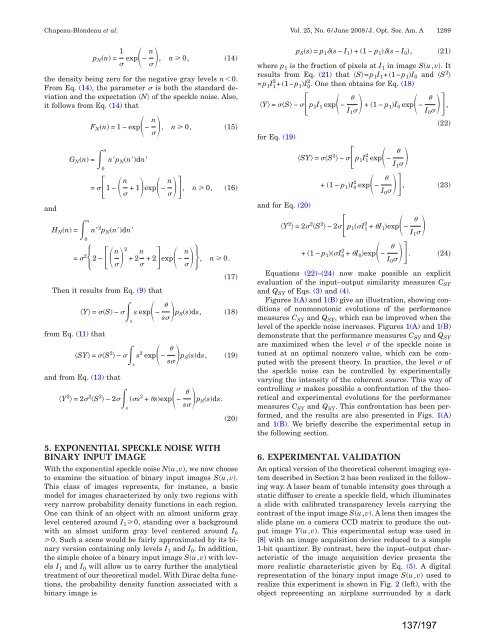a la physique de l'information - Lisa - Université d'Angers
a la physique de l'information - Lisa - Université d'Angers
a la physique de l'information - Lisa - Université d'Angers
You also want an ePaper? Increase the reach of your titles
YUMPU automatically turns print PDFs into web optimized ePapers that Google loves.
Chapeau-Blon<strong>de</strong>au et al. Vol. 25, No. 6/June 2008/J. Opt. Soc. Am. A 1289<br />
pNn = 1 n<br />
exp− n 0, 14<br />
,<br />
the <strong>de</strong>nsity being zero for the negative gray levels n0.<br />
From Eq. (14), the parameter is both the standard <strong>de</strong>viation<br />
and the expectation N of the speckle noise. Also,<br />
it follows from Eq. (14) that<br />
and<br />
F Nn =1−exp− n<br />
n<br />
GNn =0<br />
npNndn , n 0, 15<br />
= 1− n<br />
n<br />
+1exp− n 0, 16<br />
,<br />
n<br />
HNn =0<br />
n2pNndn n<br />
= 22− +2 n<br />
n<br />
+2exp− n 0.<br />
,<br />
2<br />
<br />
Then it results from Eq. (9) that<br />
from Eq. (11) that<br />
Y = S − s<br />
SY = S 2 − s<br />
and from Eq. (13) that<br />
Y 2 =2 2 S 2 −2s<br />
s exp− <br />
s 2 exp− <br />
s 2 + sexp− <br />
17<br />
sp Ssds, 18<br />
sp Ssds, 19<br />
sp Ssds.<br />
20<br />
5. EXPONENTIAL SPECKLE NOISE WITH<br />
BINARY INPUT IMAGE<br />
With the exponential speckle noise Nu,v, we now choose<br />
to examine the situation of binary input images Su,v.<br />
This c<strong>la</strong>ss of images represents, for instance, a basic<br />
mo<strong>de</strong>l for images characterized by only two regions with<br />
very narrow probability <strong>de</strong>nsity functions in each region.<br />
One can think of an object with an almost uniform gray<br />
level centered around I10, standing over a background<br />
with an almost uniform gray level centered around I0 0. Such a scene would be fairly approximated by its binary<br />
version containing only levels I1 and I0. In addition,<br />
the simple choice of a binary input image Su,v with levels<br />
I1 and I0 will allow us to carry further the analytical<br />
treatment of our theoretical mo<strong>de</strong>l. With Dirac <strong>de</strong>lta functions,<br />
the probability <strong>de</strong>nsity function associated with a<br />
binary image is<br />
p Ss = p 1s − I 1 + 1−p 1s − I 0, 21<br />
where p 1 is the fraction of pixels at I 1 in image Su,v. It<br />
results from Eq. (21) that S=p 1I 1+1−p 1I 0 and S 2 <br />
=p 1I 1 2 +1−p1I 0 2 . One then obtains for Eq. (18)<br />
Y = S − p1I1 exp− <br />
+ 1−p1I0 exp−<br />
I1 <br />
for Eq. (19)<br />
and for Eq. (20)<br />
SY = S 2 − p 1I 1 2 exp− <br />
+ 1−p 1I 0 2 exp− <br />
I 1<br />
I 0,<br />
22<br />
I 0, 23<br />
Y 2 =2 2 S 2 −2p 1I 1 2 + I1exp− <br />
+ 1−p 1I 0 2 + I0exp− <br />
I 1<br />
I 0. 24<br />
Equations (22)–(24) now make possible an explicit<br />
evaluation of the input–output simi<strong>la</strong>rity measures C SY<br />
and Q SY of Eqs. (3) and (4).<br />
Figures 1(A) and 1(B) give an illustration, showing conditions<br />
of nonmonotonic evolutions of the performance<br />
measures C SY and Q SY, which can be improved when the<br />
level of the speckle noise increases. Figures 1(A) and 1(B)<br />
<strong>de</strong>monstrate that the performance measures C SY and Q SY<br />
are maximized when the level of the speckle noise is<br />
tuned at an optimal nonzero value, which can be computed<br />
with the present theory. In practice, the level of<br />
the speckle noise can be controlled by experimentally<br />
varying the intensity of the coherent source. This way of<br />
controlling makes possible a confrontation of the theoretical<br />
and experimental evolutions for the performance<br />
measures C SY and Q SY. This confrontation has been performed,<br />
and the results are also presented in Figs. 1(A)<br />
and 1(B). We briefly <strong>de</strong>scribe the experimental setup in<br />
the following section.<br />
6. EXPERIMENTAL VALIDATION<br />
An optical version of the theoretical coherent imaging system<br />
<strong>de</strong>scribed in Section 2 has been realized in the following<br />
way. A <strong>la</strong>ser beam of tunable intensity goes through a<br />
static diffuser to create a speckle field, which illuminates<br />
a sli<strong>de</strong> with calibrated transparency levels carrying the<br />
contrast of the input image Su,v. A lens then images the<br />
sli<strong>de</strong> p<strong>la</strong>ne on a camera CCD matrix to produce the output<br />
image Yu,v. This experimental setup was used in<br />
[8] with an image acquisition <strong>de</strong>vice reduced to a simple<br />
1-bit quantizer. By contrast, here the input–output characteristic<br />
of the image acquisition <strong>de</strong>vice presents the<br />
more realistic characteristic given by Eq. (5). A digital<br />
representation of the binary input image Su,v used to<br />
realize this experiment is shown in Fig. 2 (left), with the<br />
object representing an airp<strong>la</strong>ne surroun<strong>de</strong>d by a dark<br />
137/197


